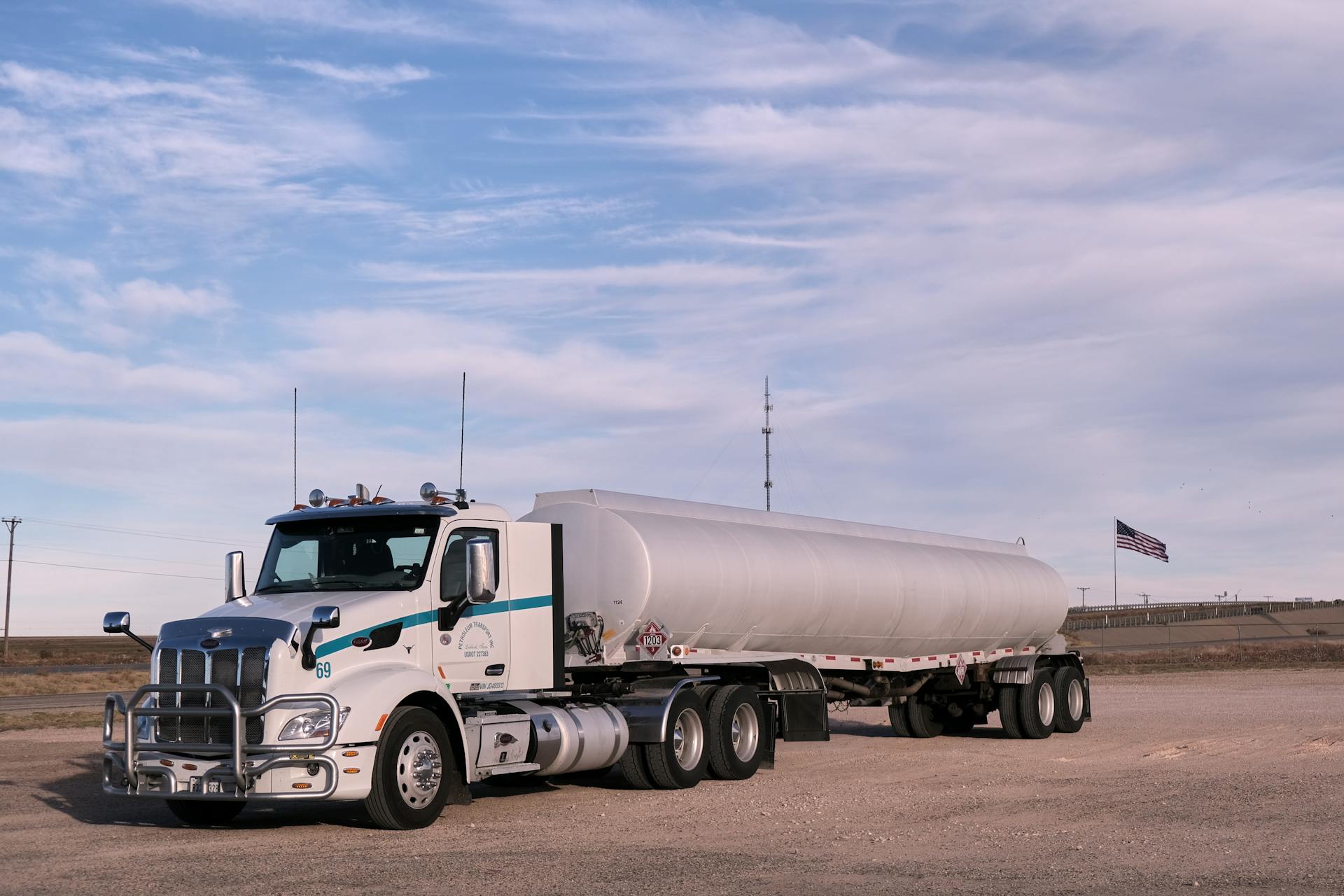
The American semi-truck industry is a behemoth, with thousands of trucks hitting the roads every day. The industry is projected to reach a market size of $52.4 billion by 2025.
Major players in the industry include companies like Peterbilt, Kenworth, and Freightliner, which have been around for decades. These companies have been innovating and pushing the boundaries of what's possible in semi-truck design and technology.
The industry has seen a shift towards electric and hybrid trucks, with companies like Tesla and Daimler introducing electric semi-truck models. This trend is expected to continue, with many companies investing heavily in electric vehicle technology.
The rise of autonomous trucks is also on the horizon, with companies like Waymo and TuSimple leading the charge.
Additional reading: Are Electric Semi Trucks Feasible
History of American Semi Trucks
American semi trucks have a rich history that dates back over a century. These trucks have evolved significantly, from simple motorized wagons to the powerful, high-tech machines we see on the roads today.
The first semi-truck was built in 1898 by Alexander Winton, an automobile manufacturer who needed a way to transport his cars to buyers without putting miles on them. This led to the creation of the first semi-truck, a modified automobile with a trailer attached to the rear.
The early 20th century marked the beginning of the American semi truck industry. Several key milestones have shaped its development, including Freightliner's rise to dominance and Navistar International Corporation's focus on heavy-duty trucks and diesel engines.
Freightliner's innovations like the all-aluminum cab set new standards for truck design and efficiency. Volvo Trucks North America entered the market in the 1980s and quickly established itself as a leader in safety and fuel efficiency.
The 21st century has brought a new wave of innovation with the rise of electric semi trucks. Companies like Tesla and Freightliner are leading the charge with models like the Tesla Semi and Freightliner eCascadia, promising zero-emission transport and reduced operating costs.
Take a look at this: Tesla Semi Trucks
Manufacturers and Models
Major American semi truck manufacturers include Daimler Trucks North America, PACCAR Inc, Navistar International Corporation, and Volvo Trucks North America.
The most popular American semi truck models are the Freightliner Cascadia, Kenworth T680, Peterbilt 579, International LT Series, and Volvo VNL, dominating the market with their advanced features and diverse models.
Freightliner is the most popular semi-truck brand in America, commanding nearly 38% of semi-truck sales in the U.S. as of 2024.
Take a look at this: New International Semi Trucks
Mack
Mack is a well-known name in the trucking industry, founded in Brooklyn, New York nearly a century ago.
Mack has been owned by Volvo since 2001, but still operates as a separate brand.
Mack makes up around 8.4% of the semi-trucks in the U.S.
Mack trucks are known for prioritizing durability over driver comfort.
The Mack Anthem is a Class 8 tractor with up to 505 horsepower under its hood.
The Mack Anthem features a comfier cab than previous Macks, with a ceiling height of over seven feet in the sleeper and modular cabins that allow for customizable storage spaces.
Mack has released smaller EV trucks, but there is still no fully-electric Mack big rig for long hauls.
Volvo, Mack's parent company, is already catering to the electric market, so it's unclear if Mack will eventually transition to an electric future.
A fresh viewpoint: Mack Semi Trucks
Freightliner

Freightliner is the most popular semi-truck brand in America, commanding nearly 38% of semi-truck sales in the U.S. as of 2024.
Their trucks are known for being reliable and durable, with a reputation for developing and incorporating advanced technology. They offer a wide range of models, including the Cascadia, which has a sleek, aerodynamic design that helps make it more fuel efficient.
Freightliner has a strong presence in the commercial truck market, producing heavy-duty class 8 diesel trucks, as well as class 5–7 trucks. They have a network of dealerships across the United States, Canada, Brazil, and Mexico.
Their trucks are built to handle all types of loads, with engine options ranging from 350 to 600 horsepower. Freightliner also offers all-electric commercial trucks, including the eCascadia and eM2 106, which have a range of up to 230 and 250 miles, respectively.
Freightliner employs over 3,000 workers in their Cleveland, MT, and Holly facilities. Their trucks are popular among drivers due to their affordability and top features.
See what others are reading: Freightliner Semi Trucks
Paccar (Manufacturers)
Paccar (Manufacturers) is a leading company in the trucking industry, founded in 1902 as a merger of McCormick Harvesting Machine Company and Deering Harvester Company. They have a rich history of innovation, including the first commercially successful diesel engine for heavy-duty trucks.
Paccar is a Fortune 500 company that designs, manufactures, and provides customer support for trucks under several nameplates, including Kenworth, Peterbilt, Leyland Trucks, and DAF. They also offer financial services and distribute truck parts.
Paccar's subsidiary, Peterbilt, is a well-known brand in the industry, accounting for about 13 percent of the market share. Peterbilt trucks are known for their sleek designs, long hoods, and striking front grilles.
Paccar's commitment to quality and innovation has made it a trusted name in the industry. They continue to design and manufacture advanced vehicles, vehicle systems, powertrain components, and software to deliver outstanding performance and value.
Paccar's brands, including Peterbilt and Kenworth, have a storied history in the trucking industry, producing iconic and reliable heavy-duty models. These brands are known for their distinctive grilles and customizable features.
Paccar's headquarters are located in Kirkland, Washington, and they have a strong presence in the Americas, with a focus on producing rugged, reliable, and super-efficient trucks.
Explore further: Are Volvo Semi Trucks Reliable
Differences Between European
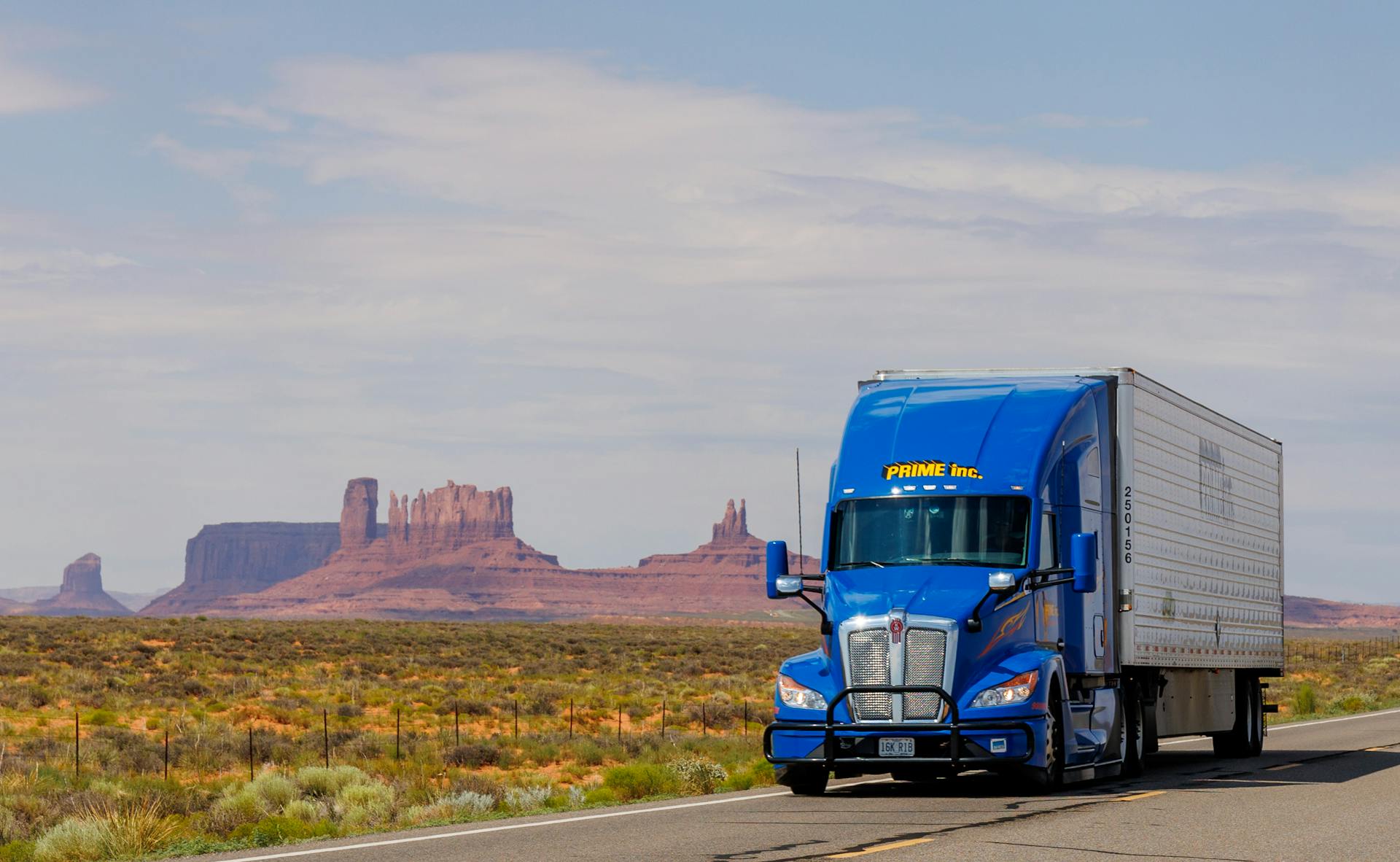
European manufacturers tend to focus on precision and quality, as seen in the case of Mercedes-Benz, which emphasizes attention to detail in their manufacturing process.
The European market is known for its high-performance vehicles, with brands like Ferrari and Lamborghini pushing the limits of speed and power.
In contrast, American manufacturers often prioritize comfort and practicality, as evident in the design of the Ford F-150, which prioritizes interior space and towing capacity.
European models often have a more compact design, such as the Mini Cooper, which is ideal for navigating tight city streets.
American models, on the other hand, tend to be larger and more spacious, like the Chevrolet Silverado, which is designed for long road trips.
Some European manufacturers, like BMW, focus on offering a wide range of models with varying engine options, catering to different driving styles and preferences.
In contrast, some American manufacturers, like Dodge, specialize in producing high-performance vehicles with powerful engines, often at the expense of fuel efficiency.
Design and Regulations
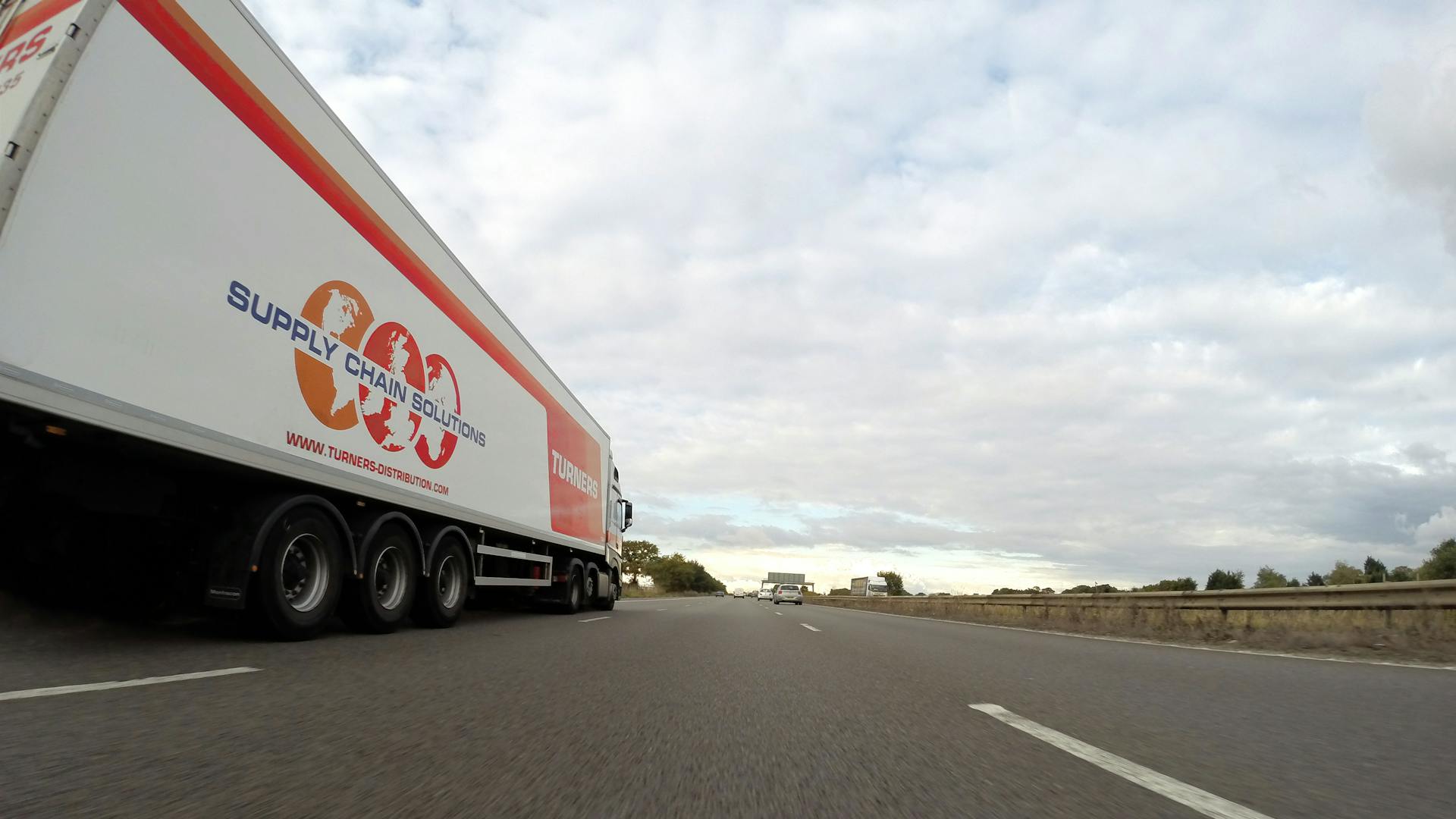
American semi trucks have distinct design differences compared to their European counterparts. The most notable difference is the design of the cab, with American trucks often featuring a long-nosed design, also known as a conventional cab.
This design allows for a larger engine bay, making maintenance easier and improving aerodynamics. In contrast, European trucks commonly feature a cab-over-engine (COE) design, where the cab is directly above the engine, resulting in a flat-nosed appearance.
Regulations play a significant role in shaping the design and functionality of American semi trucks. Length limits, for example, are only regulated for the trailer in the U.S., allowing for longer tractor units.
In Europe, the entire vehicle length is regulated, encouraging the use of cab-over designs to maximize cargo space. This is just one of the key differences in regulations between the two regions.
Here are some key differences in regulations between the U.S. and Europe:
- Length Limits: U.S. regulates only trailer length, while Europe regulates entire vehicle length.
- Emissions Standards: Both regions have strict emissions standards, but differ in specifics, with Europe's Euro standards updated more frequently.
- Axle Weight Regulations: U.S. has varying state-to-state axle weight limits, while Europe has more uniform regulations across countries.
Design Differences
American semi trucks often have long-nosed designs, also known as conventional cabs. This design is popular due to the larger engine bay, which allows for easier maintenance and better aerodynamics.
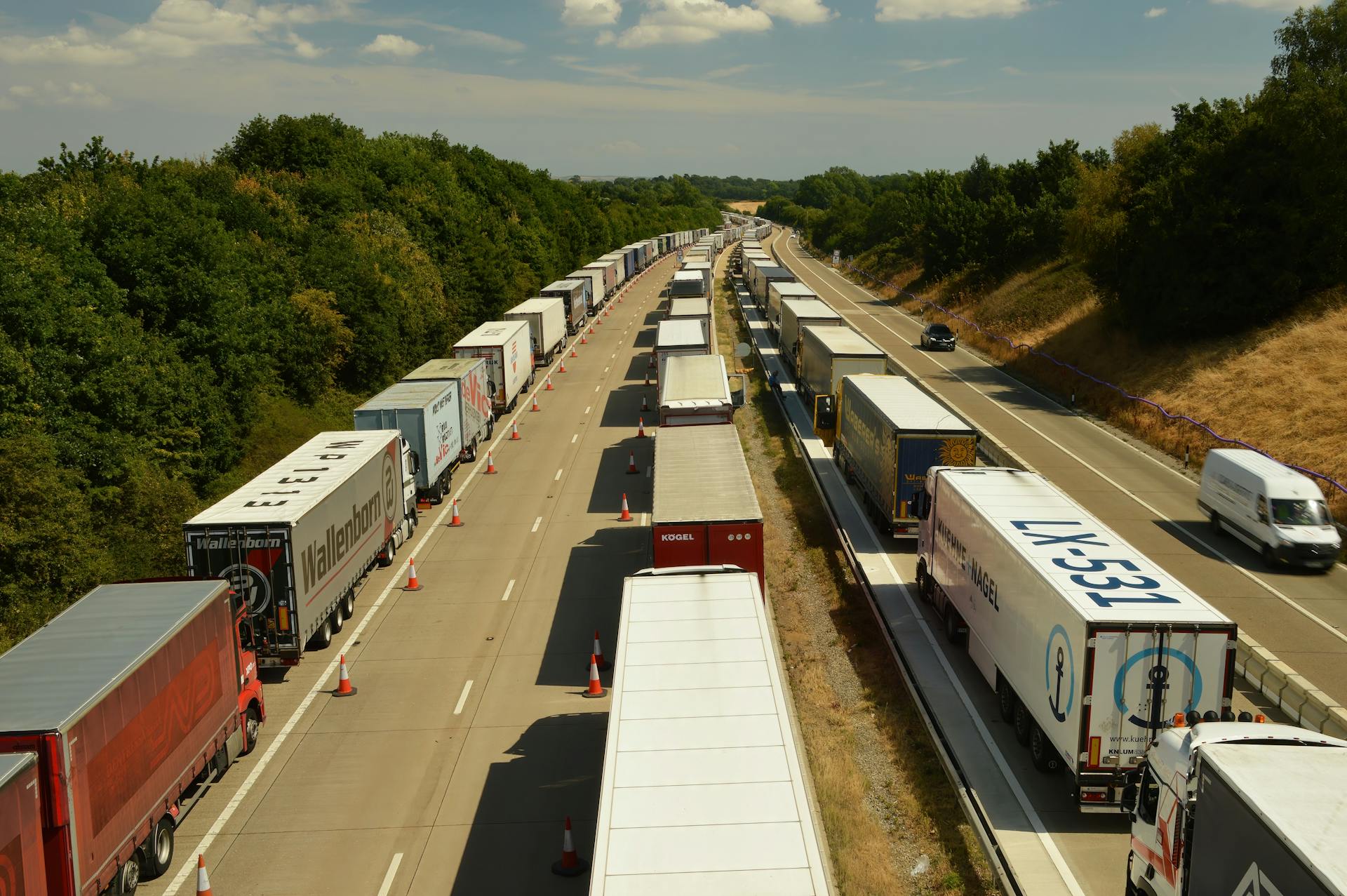
The COE design, commonly found in European trucks, results in a flat-nosed appearance. This design is more compact, allowing for longer trailers while staying within length limits.
European trucks' compact design makes them ideal for urban areas where space is limited. In contrast, American semi trucks' larger engine bays provide more room for maintenance and repairs.
Height Restrictions
Height restrictions play a significant role in the design of semi trucks. In the United States, there are no federal height limits, but most states cap the height at 13.5 to 14 feet.
European trucks, on the other hand, must conform to stricter height restrictions. These restrictions are generally around 13 feet, which is equivalent to 4 meters.
For your interest: Height of Semi Truck
Regulations
Regulations play a significant role in shaping the design and functionality of American semi trucks versus their European counterparts.
In the U.S., only the trailer length is regulated, allowing for longer tractor units. This leads to a different design approach compared to Europe, where the entire vehicle length is regulated, encouraging the use of cab-over designs to maximize cargo space.
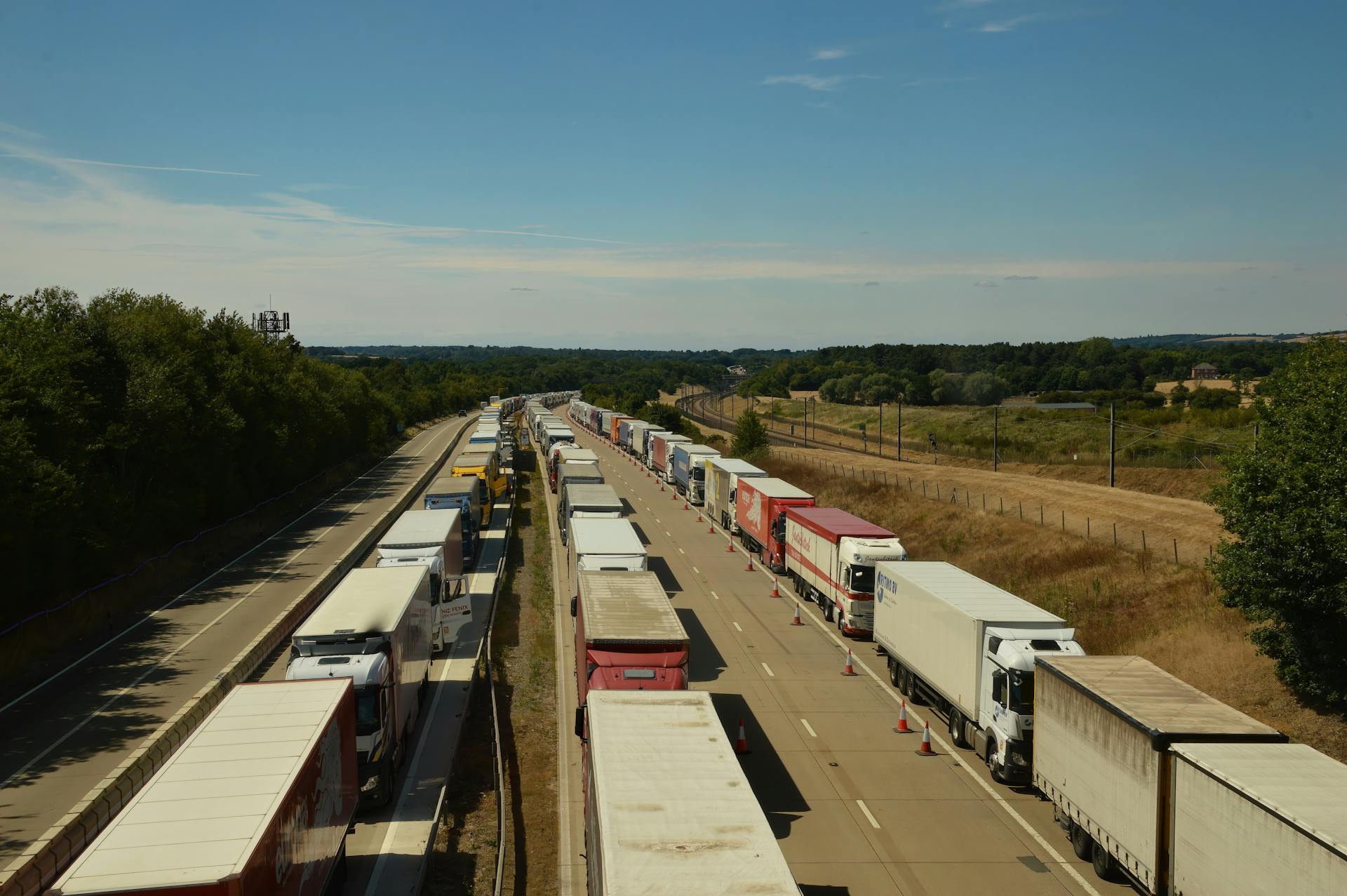
European trucks often need to comply with Euro standards, which are updated more frequently, whereas American trucks must meet EPA standards, which focus on reducing emissions but have different criteria.
Axle weight regulations vary greatly between the U.S. and Europe. In the U.S., axle weight limits differ from state to state, affecting how trucks are loaded and operated.
Here's a comparison of axle weight regulations in the U.S. and Europe:
These differences in regulations are essential to understand when appreciating the unique characteristics of American semi trucks.
Industry Trends and Developments
The American semi truck industry is constantly evolving, with new trends and developments emerging all the time. One notable trend is the increasing adoption of autonomous technology, with companies like Daimler and Waymo already testing self-driving trucks on public roads.
The use of alternative fuels is another key development in the industry, with many truck manufacturers now offering diesel-electric and natural gas-powered options. These alternatives are more environmentally friendly and can also save truckers money on fuel costs.
As the industry continues to grow and change, it's likely that we'll see even more innovative solutions and technologies emerge, making American semi trucks safer, more efficient, and more sustainable.
Suggestion: Semi Truck Transportation
International
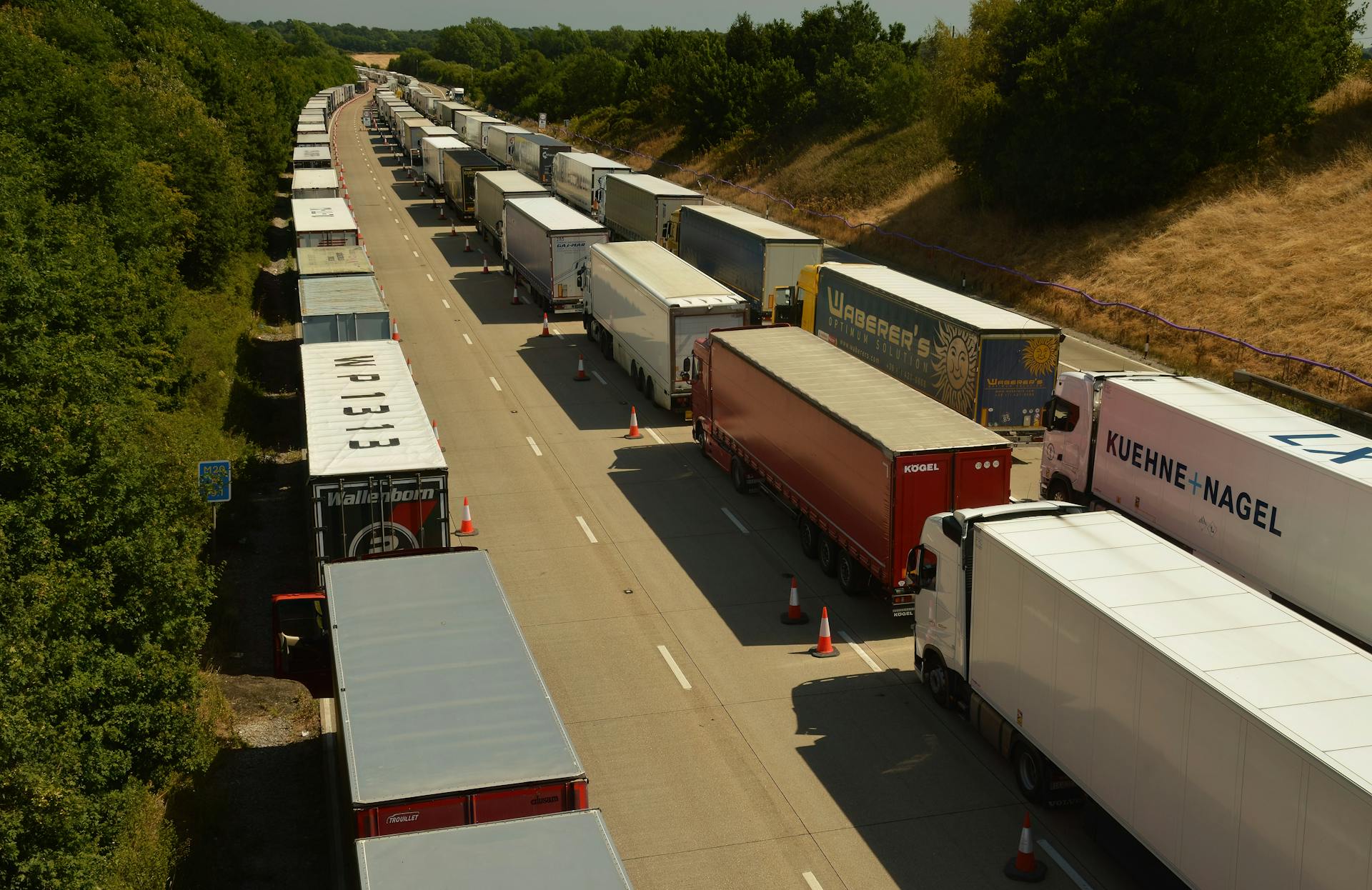
International is a leading manufacturer of commercial trucks, buses, and defense vehicles, with a rich history dating back to 1902.
The company has a significant market share in the commercial trucking industry, holding an 11 percent market share in the United States.
Their products are sold through a network of nearly 1,000 dealer outlets in the United States, Canada, Brazil, and Mexico.
Navistar has 16,500 employees and a 2013 annual revenue of $10.7 billion dollars.
Their commitment to quality and innovation has made them a trusted name in the industry, with a history of introducing innovations such as the first commercially successful diesel engine for heavy-duty trucks.
The company's trucks are known for their durability and performance, particularly in demanding tasks such as transporting cattle, horses, and other livestock.
Electric Vehicle Rise
The electric vehicle rise is transforming the trucking industry in a big way. The Tesla Semi, Nikola, Freightliner eCascadia, and Volvo VNR Electric are leading the charge with their electric commercial vehicles.
Take a look at this: Electric 18 Wheelers
These electric semi trucks are paving the way for a more sustainable future. They're not just limited to current models, but also anticipate the introduction of new all-electric commercial vehicles.
The rise of electric semi trucks is a significant shift from traditional fossil fuel-powered vehicles. Brands are investing heavily in electric technology to stay ahead of the curve.
Electric commercial vehicles like class 8 and class 5-7 trucks are becoming increasingly popular. They offer a cleaner and more environmentally friendly alternative to traditional trucks.
The industry is taking notice of the benefits of electric vehicles. Brands are not only focusing on the current models but are also anticipating the introduction of new all-electric commercial vehicles.
A fresh viewpoint: Tesla Electric Semi Trucks
Paccar Inc
Paccar Inc is a heavy-duty truck manufacturer that produces both Peterbilt and Kenworth semi-trucks.
Paccar Inc is a Fortune 500 company with a long history of producing iconic and reliable heavy-duty trucks.
Their brands, Peterbilt and Kenworth, have a storied history in the trucking industry, with Peterbilt being founded in 1939 in Oakland, California, by T.A. Peterman.
Peterbilt started by building customized truck bodies on existing truck chassis, but introduced their first conventional-style semi-truck in 1939, setting the stage for their iconic design.
Kenworth, on the other hand, was founded in 1923 by brothers George T. and Louis Gerlinger, Junior, and is celebrating its 100th anniversary in 2023.
Kenworth trucks are often characterized by their distinctive grilles and customizable features, and their headquarters are located in Kirkland, Washington.
Paccar designs and manufactures powertrains, provides information technology support, and financial services, making them a one-stop-shop for truck owners and operators.
Their trucks, including Kenworth and Peterbilt models, have a significant market share, with Kenworth holding around 14% of the market share and annual revenue of $19.1 billion.
Kenworth trucks are known for their user-friendly navigation and driver-assist technology, making them a popular choice among truckers.
You might enjoy: Semitrailer Truck
Operations and Services
American semi trucks are a vital part of the country's transportation infrastructure, with millions of tons of goods transported across the country every year.
The average semi truck travels around 100,000 miles per year, which is equivalent to driving around the Earth nearly 4 times.
Semi trucks are equipped with advanced technology, including GPS and satellite communication systems, to ensure safe and efficient transportation of goods.
The largest semi truck manufacturer in the US is Kenworth, which produces over 30,000 trucks per year, with a significant portion being sold to major logistics companies.
Factoring for Companies
Factoring for Companies can be a game-changer for businesses looking to manage their cash flow. Factoring involves selling outstanding invoices to a third-party company, allowing you to receive immediate payment.
Truck Factoring is a specialized form of factoring designed specifically for trucking companies. Best Factoring Company for Trucking is a title that some companies strive for, but it's essential to find a reputable and trustworthy factoring partner.
If you're considering factoring for your company, it's crucial to do your research and find a factoring company that meets your needs.
Dispatch Service
Our dispatch service is a key part of our operations, ensuring that orders are fulfilled efficiently and effectively.
We have a dedicated team of dispatch coordinators who work closely with our warehouse staff to ensure that orders are picked, packed, and shipped on time.
Our dispatch service operates 24/7, allowing us to fulfill orders at any time of the day or night.
Our team uses specialized software to track orders and manage the dispatch process, reducing errors and increasing efficiency.
This software allows us to automatically generate shipping labels and track packages in real-time, keeping our customers informed throughout the shipping process.
Frequently Asked Questions
What is the best semi-truck in America?
The most reliable semi-truck brands in America are Freightliner, Kenworth, and Peterbilt, known for their durability and strong resale value. Mack is also a top choice for rugged vocational applications, but the best semi-truck for you will depend on your specific needs and preferences.
Why are American semi trucks different?
American semi trucks are designed to handle the country's varied terrain and heavy loads, requiring more power for acceleration and control. This unique combination of size, weight, and terrain demands a specialized vehicle that can deliver exceptional performance and reliability.
What are the 7 types of freight trucks?
There are seven main types of freight trucks, including semi-trailers, flatbeds, step decks, dry vans, reefers, box trucks, and tankers. Each type is designed to haul specific types of cargo safely and efficiently.
Sources
- https://chartertrucks.com/blog/7-largest-semi-truck-manufacturers-in-the-us/
- https://appletruckandtrailer.com/american-semi-trucks/
- https://www.slashgear.com/1670414/semi-trucks-most-popular-america/
- https://www.topmarkfunding.com/most-popular-semi-trucks-in-america/
- https://www.maxtruckers.com/top-4-american-semi-truck-manufacturers/
Featured Images: pexels.com


